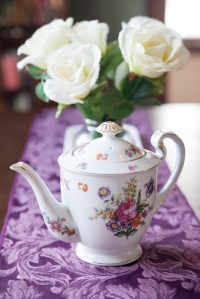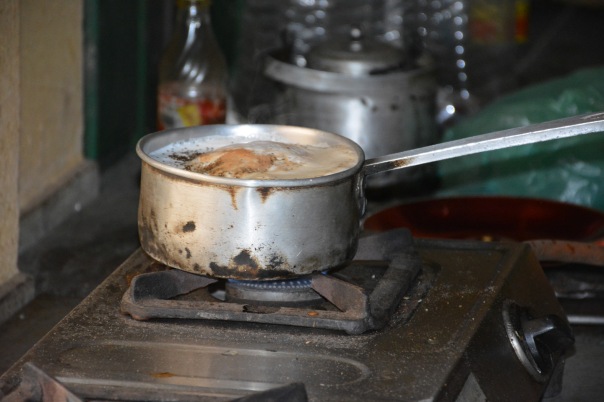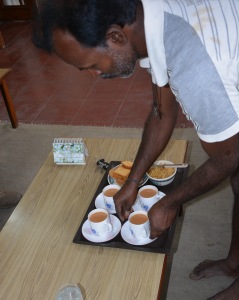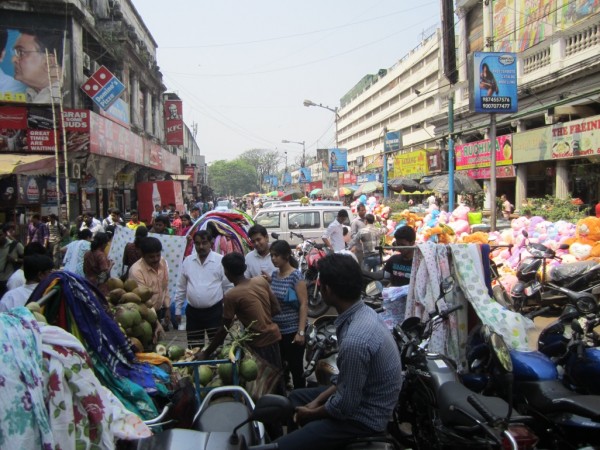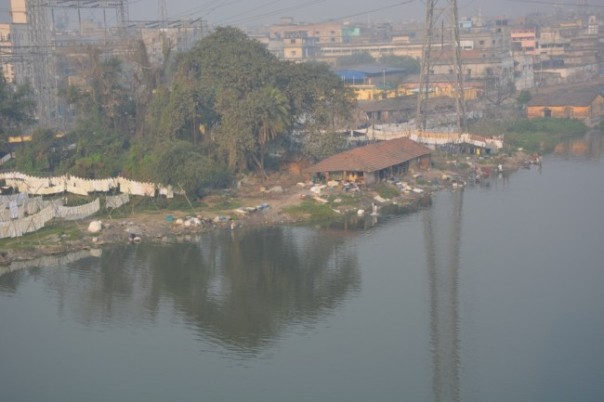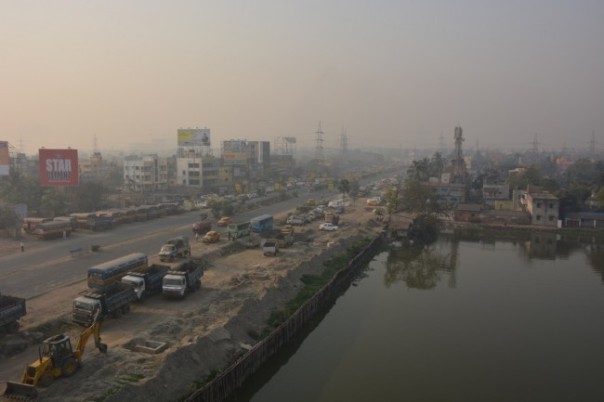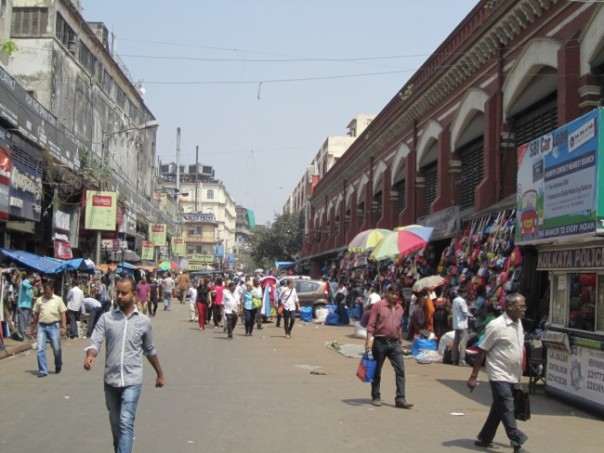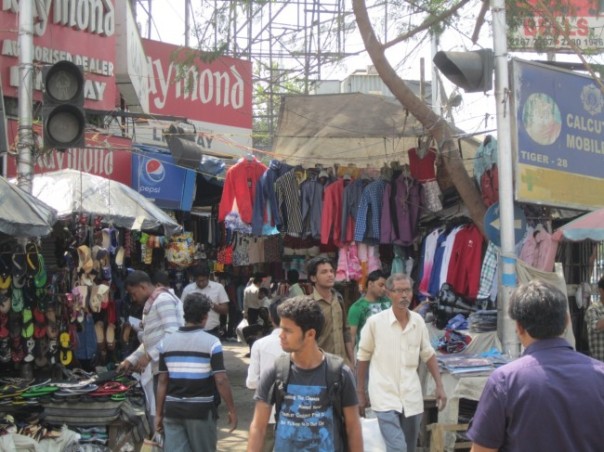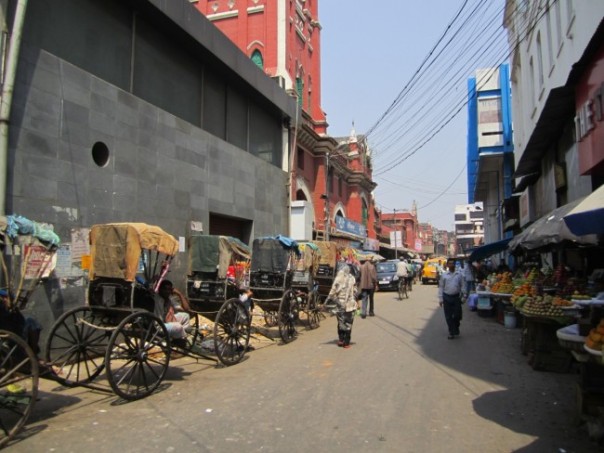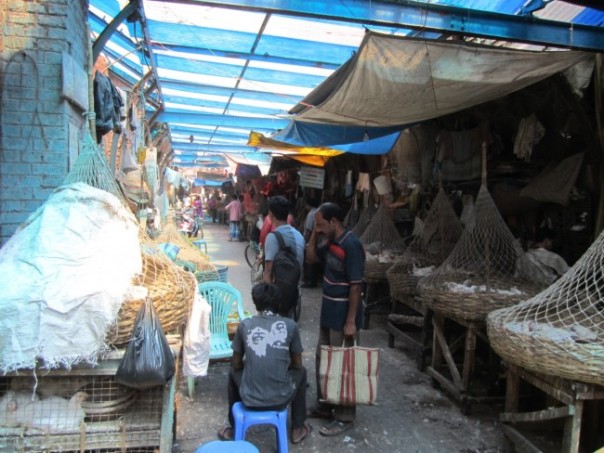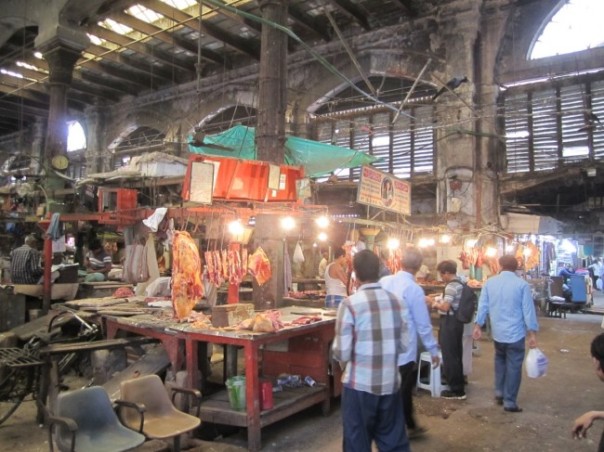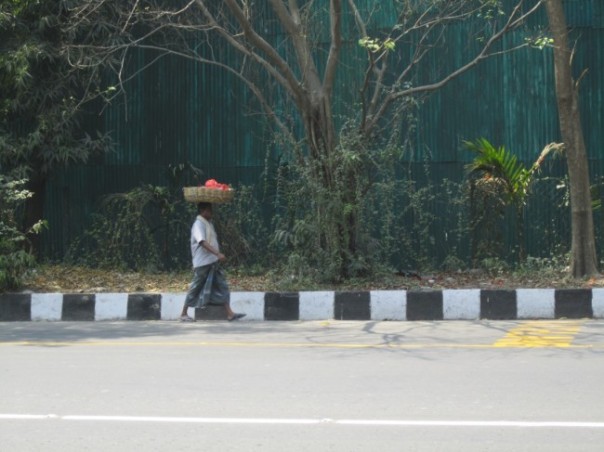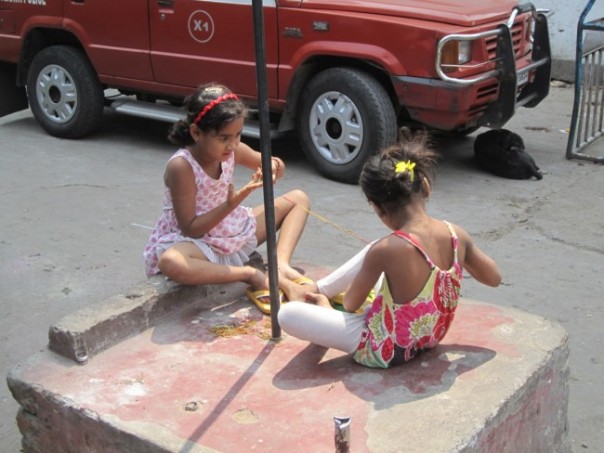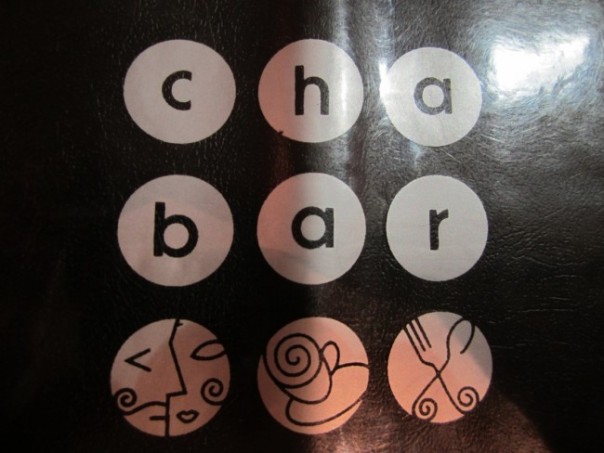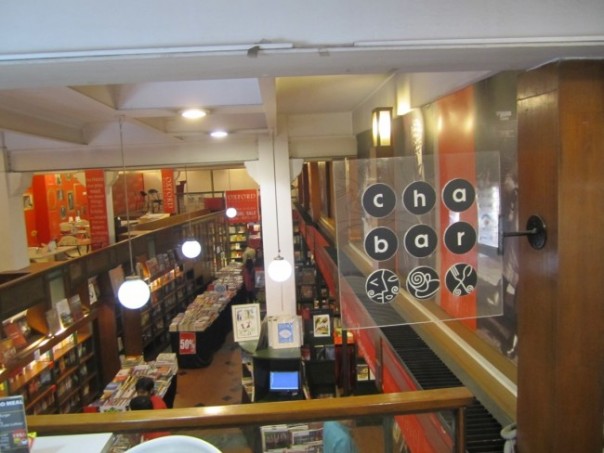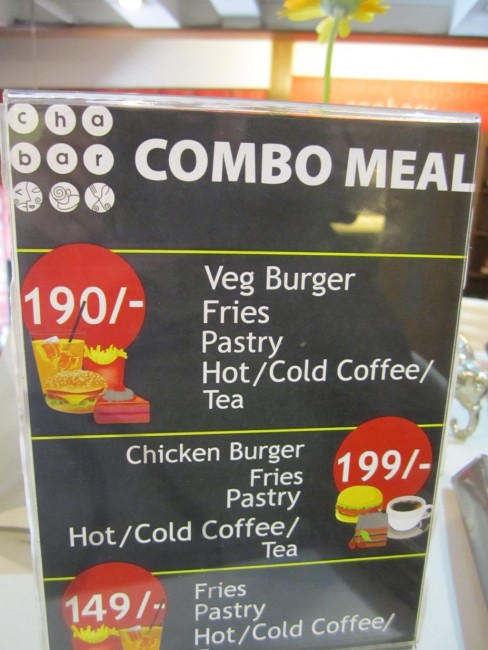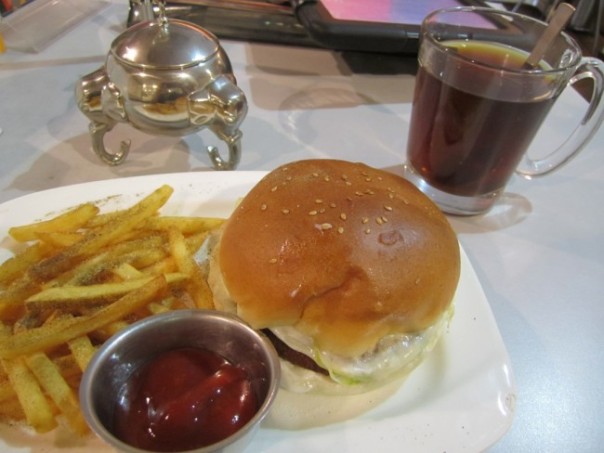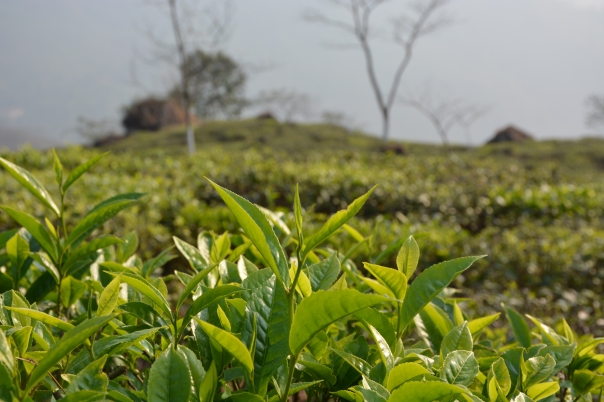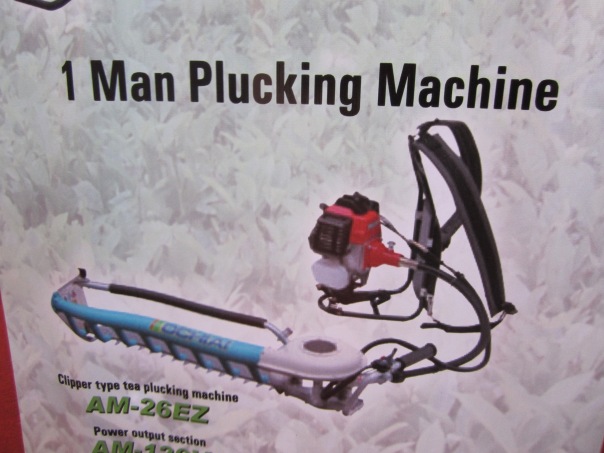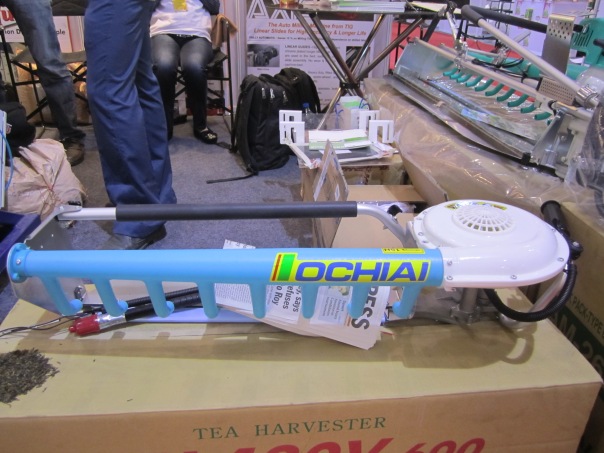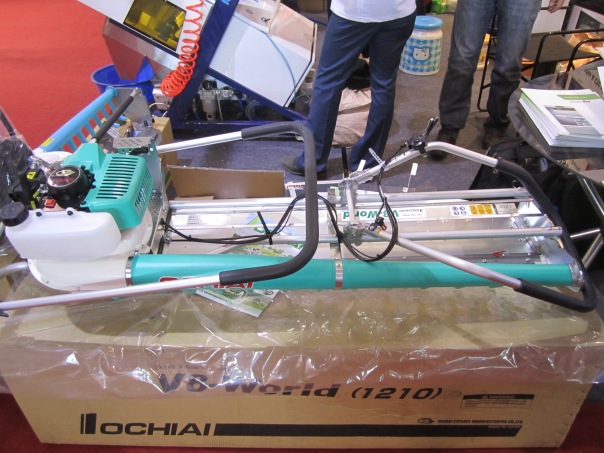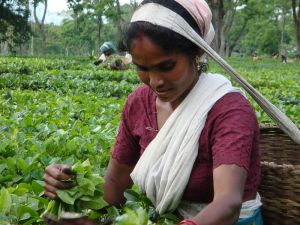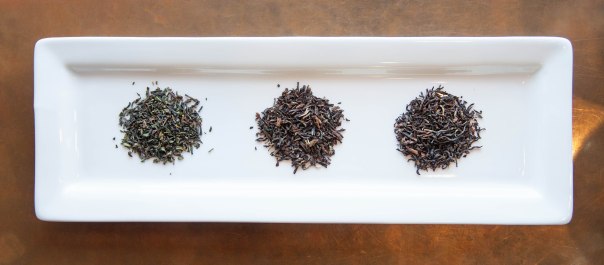-
Short History
It is said the Zen priest Eisai (pictured right) brought tea seeds to Kyoto in 1191 and popularized the consumption of powdered tea. It wasn’t until the fifteenth century that a new culture around tea evolved into the modern tea ceremony known as Chanoyu (literally translated “hot water for tea”). The tea ceremony is an extremely structured and studied ritual that embodies many philosophical, artistic, and aesthetic concepts unique to Japanese culture.Uses For Matcha
Traditionally, a powdered green tea called matcha is used during the tea ceremony, along with an array of traditional utensils. Matcha can also be prepared casually and is often used in recipes for ice cream, chocolate, and smoothies. The tea ceremony is just one way to appreciate the act of making and serving matcha, but it is by no means the only way.Production
Matcha is made from the tea leaves similar to those grown to make Gyokuro, a high grade tea that is shaded for the last three weeks before plucking. The shading causes the plant to produce more chlorophyll, giving both the leaf and the liquor a brilliant emerald color. These leaves are then stone ground into a powder to make matcha. High grade matcha steeps up sweet and slightly bitter with a taste of the sea. Japanese teas are distinct for three main reasons: they are machine harvested, they are often shaded before plucking (though not always), and they are steamed instead of fired.How Do I Make Matcha?
It is not difficult to make matcha at home using the traditional utensils. In fact, it affords an opportunity to develop a ritual of your own. You do not have to be a tea master to enjoy preparing matcha.Supplies
Here’s what you’ll need to get started.
-Bamboo tea scoop
-Tea bowl
-Bamboo tea whisk
-Small strainer
-Ceremonial grade matchaDirections
- Heat the tea bowl with a small amount of hot water, the same way you would warm a teapot.
- Using a bamboo scoop, measure two heaping scoops (0.75 grams) into your tea bowl. (NOTE: It is important to sift the matcha through a strainer to remove any clumps.)
- Heat your water to a rolling boil and add a small amount of cold water to bring the temperature down to 175 – 185 degrees.
- Measure approximately ¼ cup of water and pour it into the bowl.
- Whisk the matcha vigorously for 15-20 seconds. Small bubbles will start to appear on the top of the liquid. TIP: The whisking action comes from the wrist; your arm should not move at all. Make “M” or “W” shapes with the whisk, careful not to let it touch the bottom of the bowl. This will fully aerate the tea as it dissolves.
“Yet what is truly amazing is that nothing special or extraordinary takes place. The host and guests simply engage in the act of making and drinking tea. But it is this act that is important, for in the smallness of the tea room, the whole universe – heaven, earth, and life itself – can be evoked.” -Yasushi Inoue
-
Spring feels like the perfect time of year to host afternoon tea. The temperatures have risen, the sun shines brighter, gardens and flowers are in bloom, and homes have undergone their yearly spring cleaning. People are out and about, ready to converse and connect again.
A few of us at TeaSource had the pleasure of spending a day together planning an afternoon tea of our own! We enjoyed preparing food, drinking tea, taking photos, and of course, eating! We wanted to share our recipes and ideas with you so that you could host a party of your own, be it for Mother’s Day, a birthday party, or just because!
Jess Jellings, a former TeaSource employee and cook extraordinaire, is the mastermind behind all of the recipes you see here. THEY ARE DELICIOUS. There isn’t enough space here to gush about her creativity and skills in the kitchen. Gretchen Pruett, our fabulous photographer, captured the beauty and simplicity of the finished products before they disappeared into our mouths. Bon appétit!
Menu
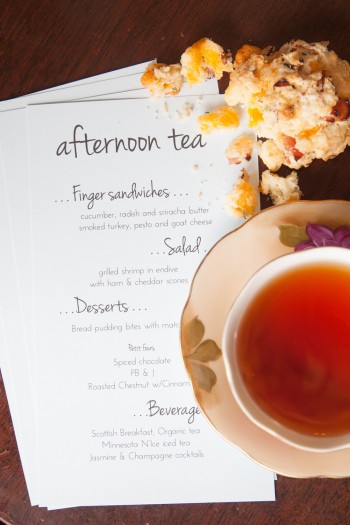
Finger Sandwiches… cucumber, radish, and sriracha butter smoked turkey, pesto, and goat cheese
Salad… grilled shrimp in endive with ham and cheddar scones
Desserts… bread pudding bites with matcha glaze
Petit Fours… spiced chocolate PB & J roasted chestnut with cinnamon
Beverages... Scottish breakfast, organic Minnesota N’Ice iced tea Jasmine & Champagne cocktails
Cucumber, Radish and Sriracha Butter Finger Sandwiches
Makes 1 dozen6 slices bread
1 english cucumber, sliced
3 radishes, thinly sliced
Sriracha butter (see below)Spread a thin layer of butter on each slice of bread. Layer cucumbers and radishes on three slices of bread, top with remaining three slices. Cut the crusts off each sandwich and cut into four finger sandwiches.
For the Sriracha Butter:
1 stick butter, softened
2-3 tablespoons sriracha (depends on your taste)Using a fork or beater, mix the butter and sriracha until well combined. If you have any left over, try it on popcorn, it’s fabulous.
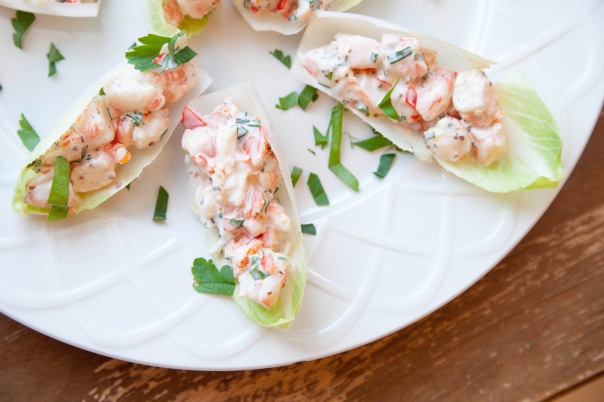
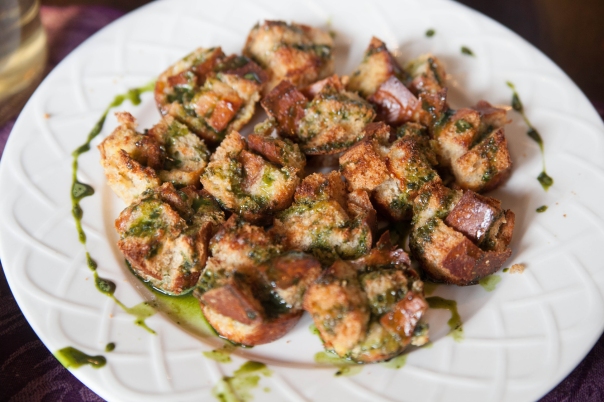
Mini Bread Puddings with Matcha Glaze
Makes 2 dozen minis (or one 9x9 baking dish)1 cup milk
2 eggs
1/3 cup sugar
1 teaspoon vanilla
3 tablespoons melted butter
1 teaspoon cinnamon
¼ teaspoon salt
4 cups bread, cubedGlaze:
¼ cup powdered sugar
1 tablespoon powdered matcha
1-2 tablespoons milkPreheat oven to 350 degrees.
Prepare a 24-mini muffin tin (or 9x9 baking dish) by greasing with butter or non-stick spray. Combine milk, eggs, sugar, vanilla, butter, cinnamon and salt in a medium bowl and whisk to combine. Pour the egg mixture into the mini muffin pan, until each well is about half full (no need to be crazy here, just make sure the egg mixture is evenly distributed). If using a baking dish, add egg mixture to prepared dish. Divide the bread cubes between each well and push down slightly to soak up the egg mixture. Let sit about 30 minutes, pressing occasionally.
If using a baking dish, add the bread and let sit about 30 minutes.Bake for 15-20 minutes until set and golden. Combine the powdered sugar, matcha and 1 tablespoon of milk in a small bowl and stir to combine. You want the glaze to fall in a thick ribbon, add the additional milk, if needed. Drizzle over the bread puddings and serve warm.

Roasted Chestnut Petit Fours
Makes 4 dozen (or one 9x13 cake, depending on how you wish to serve)
1 ¾ cups all purpose flour
2 cups sugar
¾ cup malted milk powder
1 ½ teaspoons baking soda
1 ½ teaspoons baking powder
1 teaspoon salt
1 ½ teaspoons cinnamon
2 teaspoons Roasted Chestnut Tea, ground fine
2 eggs
1 cup milk
½ cup vegetable oil
2 teaspoons vanilla
1 cup hot Roasted Chestnut Tea, brewed double strength
½ cup roasted walnuts, for garnish
Frosting (recipe below)Preheat oven to 350 degrees. In a large mixing bowl, combine all of the dry ingredients and whisk well to combine. Stir in the eggs, milk, oil and vanilla. Whisk for two minutes until all ingredients are well incorporated. Using a spoon, slowly stir in the hot tea. DO NOT OVERMIX, batter should appear very thin. Pour into an ungreased 9x13 baking dish and bake for 30-40 minutes until a toothpick inserted in the center comes out clean.
If you wanted to make a cake, let cool completely before adding frosting and walnuts. If you want to make petit fours, let the cake cool completely and freeze for 1-2 hours to make it easier to cut into 1x1 squares. Pipe a small floret onto each petit four and top with a walnut half. Chill until ready to serve.
Frosting:
1 stick softened butter
1 teaspoon cinnamon
1 cup powdered sugarMix in a large bowl using an electric mixer, about 2 minutes until fluffy.

Jasmine & Champagne cocktails
1 part cold brewed Jasmine, chilled
1 part Champagne, chilledFill a champagne flute halfway with Jasmine, then top off the glass with champagne. Adjust to your personal taste. Cheers! Cold brew iced tea instructions here.
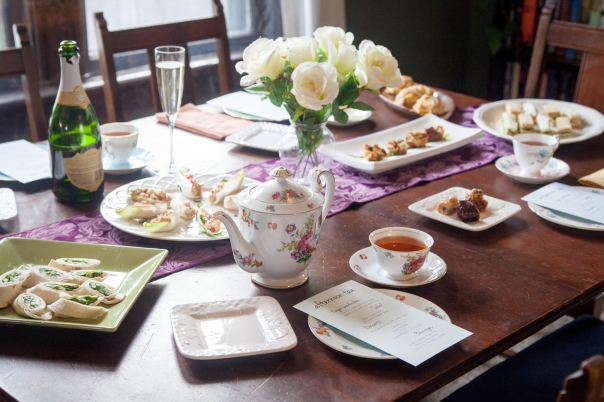
We paired Scottish Breakfast, Organic and Minnesota N’Ice with our afternoon tea. However, a floral green like Cherry Blossom Green, a straight green like Huang Shan Mao Feng, or an herbal such as Scarlet O'Peara would also compliment this spread nicely.
More recipes can also be found here. Enjoy!
-
“I’ve never heard of that kind of tea before.” Bill Waddington
Milk tea being made at the Rohini Estate, Darjeeling, India.
It’s not very often that I say those words. But it happened while I was in India last month. Almost every tea place I stopped in - street stalls, tea broker’s offices, tea gardens - I would be asked if I wanted tea. Of course I would say “yes.” I would be asked if I wanted “black tea” or “milk tea.” And this gave me pause.
Milk tea being served at the Rohini Estate, Darjeeling.
At first I thought they just meant a black tea served with milk on the side. But it became clear this was not what they meant. “Milk Tea” was a completely different/unique concoction: not black tea, not tea with milk, not “Royal Milk Tea,” not boba or bubble tea, not chai tea (or masala chai). I already knew all of those. Milk tea is its own thing. So of course I asked for it. Then asked for it at the next place, and the next place ... It’s reaalllly good. It is strong, sweet, smooth, milky (duh), and the method of preparation totally took me by surprise. In the interest of full disclosure my wife did not like it, but EVERYONE at TeaSource did.
This is one of the things I most love about tea: almost every culture in the world drinks tea-and almost all of them do something different with it. Tea snobs be damned.
On Thursday, April 17 at Noon (CST) I will be doing a Livestream broadcast, demonstrating how to make Indian Milk Tea. To participate, just click here, log in, then sit back and enjoy!
FYI, we try to do Livestream broadcasts approximately once a month. All are welcome to watch and participate. We announce these on Twitter and Facebook, as well as our monthly email newsletter.
Thanks, -Bill
View Post About Travels in Tea: India, Part 4 - Livestream Broadcast
-
In Kolkata I ended up staying in a very cheap, barebones, locals-only hotel, in a neighborhood where I was the only westerner for miles; because it was the closest hotel to the convention center, only 3 km away. I could walk to the convention. All other hotels (re: higher rated and more expensive) were all 6-10 km away from the convention center. The moral here is never trust the pictures you see on internet travel sites. I certainly got a chance to see “authentic” Kolkata, not just the touristy parts, although I saw some of that too. The most annoying thing about clichés is that they are often true. Kolkata, a teaming mass of humanity … Lots of people, noisy crowded streets, mullahs chanting, music constantly being played over public loudspeakers, public ablutions, the poorest poor-the richest rich, friendly/helpful people-lots of stares 'what's he doing here.' Smells: spices-people-industry-motor fumes-trash and litter. Hot-dusty-dry, mosquitoes, livestock all over the roads (not just cows), dirt roads, CRAZY drivers, push carts, stalls with all manner of goods, lively, thriving, throbbing, pulsing ... Kolkata - City of Joy.
View from my hotel room, toward the back of the hotel.
View from my hotel room, toward the back, doing the laundry.
View from my hotel: toward the front- the street the hotel is located on.
For the record, this was not the roughest hotel room I have ever stayed in - that would have been in Guthrie Center, Iowa.
Near my hotel room and the convention center: fishing and washing seem to go together.Shopping near my hotel room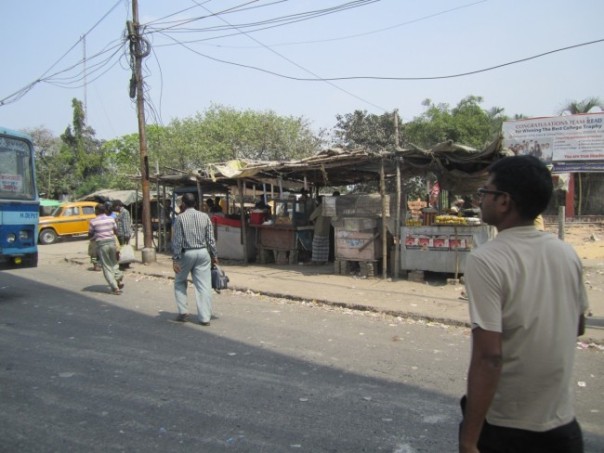
More shopping near my hotel.
Kolkata, street scenes: near Chowinghee Road
Kolkata street scenes, more shopping
Kolkata street scene: yet more shopping
Kolkata street scene: it’s starting to get crazy.
To make the shopping easier.Fruit and vegetable stands were all over India, this was a larger one. These are in lieu of what we call traditional grocery stores-the product looked great and was very fresh-think of our farmer’s markets.
Hogg Market: more fresh groceries; those are chickens running around in those cages.
Hogg Market: you can get the exact cut of meat you want.
Carrying product to the marketSisters making bracelets to sell at the market.
It took a long time, but I finally found some tea in Kolkata. I hadn’t even seen a chaiwallah. The Cha Bar was located inside Oxford Books, the best book store in Kolkata, of course in the touristy section of town.
It actually was a pretty neat layout. A pretty good selection of 50 or 60 teas. And they offered food, not a full blown restaurant, but sort of like a café or diner. I was going to order some Indian food, but then I noticed this which unfortunately really reminded me of something back in the States.
I figured I had to try the India version of a McDonalds knock off.
This, along with a pretty good Assam black tea from the Khobong Tea Garden (of course with the assumption that sugar will be used), actually wasn’t bad. Later on I did run across a real McDonalds, but they don’t serve hamburgers (this is India after all; cows are wandering around the streets-not residing between two pieces of bread). Why are the most ubiquitous American exports those things that we are kind of embarrassed about?Kolkata is very cool, a little unsettling, and definitely can make you feel like a stranger in a strange land.Up next, the hills of Darjeeling.
-Bill -
A typical street in Kolkata, India.
Ostensibly I was in Kolkata because it was a connecting point to the tea regions of Darjeeling and Assam. In addition there was a small tea convention going on there. Also, it was my first chance to visit a famous Indian city.
First, the tea convention. For the record, it was the 2nd India International Tea & Coffee Expo. To a large degree it was a bust, at least for me. It was very small, only its second year. It didn’t really have a clear idea of whom it was addressing: importers, growers, packers, retailers, exporters or whom? It was mostly for Indian tea companies, as opposed to foreigners. I was a bit of an oddity (I’m used to that). There were lots of tea garden equipment manufacturers (which was way cool), a few actual tea companies, the official tea boards of India, Darjeeling, Assam Nilgiri, and Kangra- and these were all great contacts for me to make.
Geek warning: possibly the coolest part of the convention was the tea garden equipment manufacturers. Most of you probably know almost all of the tea TeaSource sells is still hand-plucked (2 leaves & a bud).
Two leaves & a bud, waiting to be plucked at the Goomtee Tea Garden, Darjeeling, India.But there are some areas in the world that use machines to pluck tea leaves, particularly Japan. They do this because they don’t have enough skilled labor to go in the tea fields and pluck tea leaves. In fact the Japanese have almost made an art form of creating machinery that delivers a very high quality tea, while reducing the actual labor costs in producing these very high quality teas.
Here is a one person tea plucking machine pic from a catalog.
Here’s an actual one man machine.
Here is a two person tea plucking machine pic from a catalog.
Here is a picture of an actual 2 man machine. The handles fold out flat, so they can each be grabbed a tea worker.
These plucking machines are guided across the very top of the tea rows, which shaves the top very few leaves of the plant and collects them. However, this machine is certainly not as discriminating in choosing and plucking, ‘just the right leaves’ as a skilled tea plucker. This lesser degree of discrimination has led the Japanese to create another very cool machine: an electronic/digital tea leaf sorter that works by detecting the variations in the color of the individual leaves.
This is a pretty small scale color tea leaf sorter for small lots of tea.[/caption] The collected leaf is fed through the tea leaf sorter in a steady stream. Then, through the use of very high tech cameras, the color variations amongst the leaves and tea particles are registered and compared to whatever the machine’s program calls for at that time. Any leaves that are not the desired color (which is a reflection of density, moisture content, position on the plant, chlorophyll content, etc.) will be identified and knocked out of the tea leaf stream by a blast of air.A very large color tea leaf sorter, complete with Nikon lenses on its cameras - it can sort about 800 lbs. of tea per hour.[/caption] This is pretty cool stuff; kind of Star Wars meets tea manufacturing. For better or worse, we will be seeing more of this kind of the thing in the future, as shortage of labor is the second biggest challenge facing all tea manufacturers.
But as I said, the tea convention was a bit of a bust: I made some good contacts, saw some cool machines (and since it was a slow convention I had a chance to sit and chat with the guys who design and build these machines). But that was about it. The nicest thing about the convention was it gave me an extra day to explore Kolkata.
Much more on Kolkata in the next post. -Bill
-
India grows a lot of tea. It is the second largest tea producer in the world (China is first) – making over one million metric tons of finished tea per year. But the story told to us about Indian tea is actually much larger than India (and India is big!). It is also about the British empire; it is about the East India Company and the consequences of global trade; and it is about the influence of the west on the east.
Up into the 19th century, tea plants and the tea trade belonged to China. But the demand for tea was rapidly growing in the west and so were the pressures with the East. Because the Chinese had a monopoly on tea and little interest in European goods, they could demand to be paid in silver, causing the British to run significant trade deficits (an issue America and China are grappling with today).
To reverse the flow of silver back home, the British began selling large amounts of cheap opium (grown in India) to China. Furious at the British for turning their country into opium addicts (and depriving them of silver), the Chinese began confiscating and destroying the British opium supplies. The British retaliated with military force and fought what we now refer to as the first "opium war" of 1839-1842.
While these tensions were escalating, the British discovered an indigenous tea plant (camellia sinensis var. Assamica) growing in India. This was of no significance to the rest of the world until a couple employees of the East India Company began a project to start cultivating these wild tea plants in Assam.
Motivated to find a commercial alternative to Chinese tea, the British had already been experimenting with growing tea in India. The lack of experience and infrastructure (Assam was an undeveloped jungle at the time) prevented any real success up to this point, but these Assam tea plants proved well suited for the warmer climates of India. Through the stubborn persistence of the British (none of this came easy and often ended tragically) and help from imported Chinese knowledge and labor, the cultivation of tea in India became viable – and the proliferation of the Assam plant grew it to the size it is today. As the modern Indian tea industry established, three "official" geographically recognized tea producing regions emerged: Assam, Darjeeling, and Nilgiri.
Assam
The home to India’s native tea plant, Assam was a jungle surrounding the Brahmaputra River valley in east India. It currently produces over 50% of India’s total tea output and Assam teas are noted for being strong, full-bodied, with malty flavors. The indigenous Assamica plant prefers the warm, lush environment of its home and can stay productive most of the year, though 2nd flush teas are often considered the best. CTC teas are common in Assam. CTC, or "crush, tear, curl," teas are machine processed versus orthodox manufacturing. But fine orthodox teas are still available and range from their traditional deep, malty cups to sweet, almost tobacco-like flavors, similar to Yunnan teas (which is not surprising since the cultivars are similar and nearby on the map).Darjeeling
This famous tea produced at the foothills of the Himalayas in Northern India is not only unique among Indian teas, but distinguishes itself from teas grown anywhere else in the world. The British started coming to these picturesque mountains for relaxation and recuperation – the high mountain air was considered healthy and cleansing. But the high altitudes, cooler weather, and well-drained soil proved to be perfect for growing tea – particularly the Chinese tea plant, which prefers this climate over the tropical weather of Assam and Nilgiri. Darjeeling teas are known to steep up light, floral, fresh, and sometimes astringent. They also market the significant seasonal contrasts produced between the first and second flushes. (For more, read our blog post "I’m dealing Darjeeling" )Nilgiri (South India)
The teas of the "Blue Mountains" of Southern India are often overshadowed by the Darjeeling and Assam, but no less important to the story of India tea. Because of the tropical environment, Nilgiri plants (primarily the Assamica variety) will flush year round and are not separated by "flushes" like Assam and Darjeeling teas. Known for their smooth, fruity, gentle nature, the best orthodox teas from Nilgiri happen in the winter months of January and February, where sometimes even a little frostbite from the highest elevations can add unique and desirable complexity to the cup.The above is not comprehensive. There are many details to fill in, many exceptions, and still much to learn. As always, the best way to learn is to taste them, and read more.
-Michael Lannier
TeaSource manager




